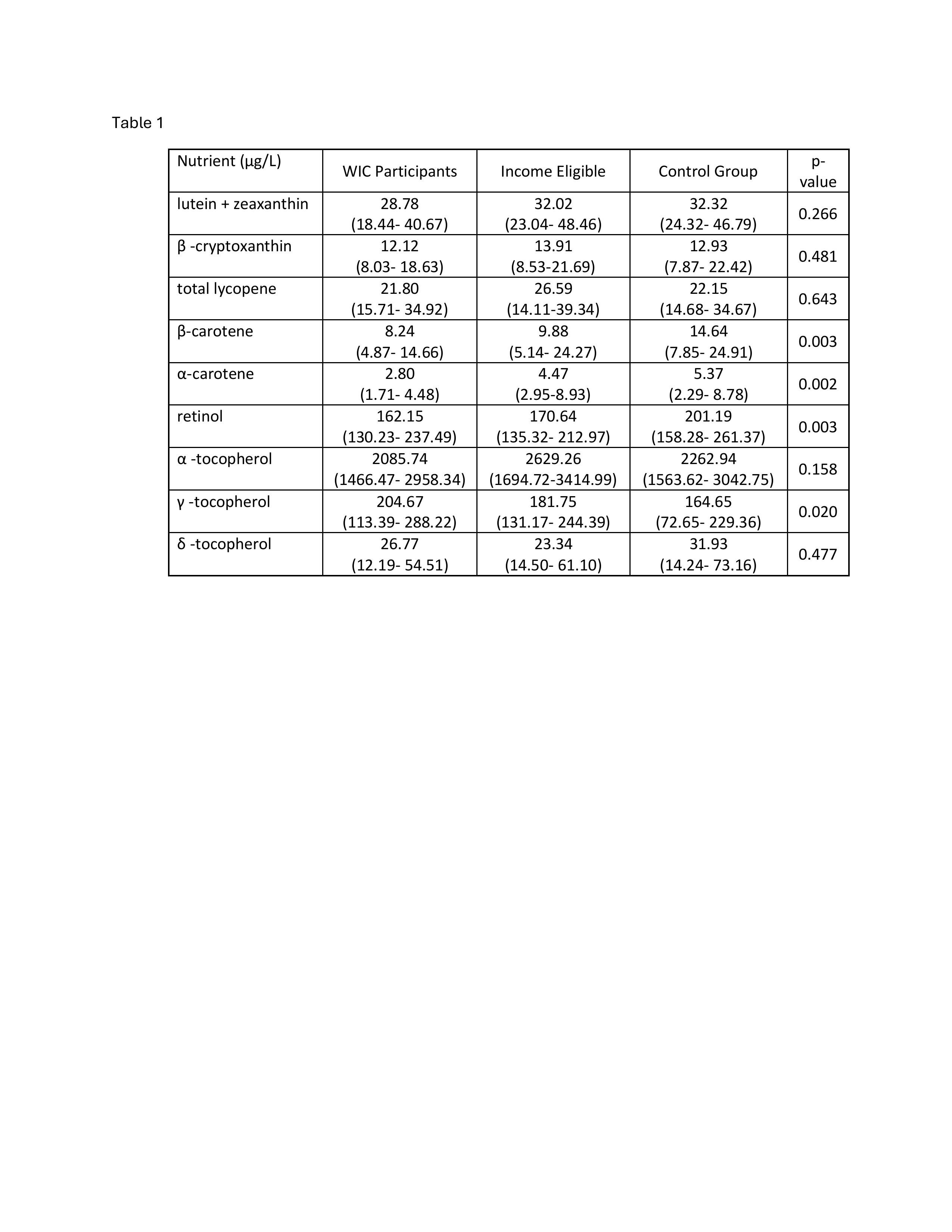Back
Background: The Special Supplemental Nutrition Program for Women, Infants, and Children (WIC) is a federal initiative designed to improve the nutritional health of low-income families. WIC supports pregnant and postpartum women and young children, offering resources for healthy growth and development during the critical early years. Nutrients that are essential for growth and development include carotenoids and tocopherols which have antioxidant qualities.
Objective: Exploring the relationship between participation in the WIC program and levels of serum carotenoids, retinol, and tocopherols in mother-infant pairs is important for understanding the value of WIC in enhancing nutritional outcomes.
Design/Methods: An IRB-approved study enrolled mother-infant pairs (n=232) at the time of delivery for collection of maternal and cord blood samples. At enrollment, 49 dyads (21.1%) were participants of the WIC program, 66 (28.4%) were income-eligible, and 117 (71.6%) were part of the high-income control group. The Kruskal-Wallis test was used to assess differences in maternal and cord blood nutrient levels between WIC participants, income-eligible non-WIC participants, and the high-income control group. Data was adjusted for smoking status, corrected gestational age, and income to poverty ratio.
Results: Data analysis of maternal blood samples showed no statistical significance in nutrient status amongst WIC participants, income-eligible participants, and the control group. Per table 1, data showed statistically lower levels of α -carotene in the cord blood of WIC participating mother-infant pairs as compared to income-eligible participants (p=0.007) and the high-income control group (p=0.003). The findings also showed lower levels of β -carotene in the cord blood of WIC participants as compared to the control group (p=0.003). Lower levels of retinol were also observed in the cord blood of WIC participating mother-infant pairs as compared to the control group (p=0.019). In contrast, higher levels of γ-tocopherol were seen in the cord blood of WIC participants as compared to the control group (p=0.038).
Conclusion(s): Interestingly, infants from low socioeconomic backgrounds whose mothers participate in the WIC program still show poorer nutritional status compared to infants of mothers from higher-income groups. These findings have significant public health implications as they shed light on the effectiveness of supplemental nutrition assistance programs for mothers and their infants. Future research will focus on evaluating additional factors, such as education, that may improve the nutrition of pregnant and postpartum women.
Median Nutrient Levels in Cord Blood Among WIC Participants, Income Eligible Non-Participants, and High-Income Groups
 Table 1 shows the median and interquartile ranges of nutrients in the cord blood of mother-infant pairs participating in WIC, income-eligible to participate in WIC, and the high-income control group.
Table 1 shows the median and interquartile ranges of nutrients in the cord blood of mother-infant pairs participating in WIC, income-eligible to participate in WIC, and the high-income control group.
Public Health & Prevention 2
Session: Public Health & Prevention 2
393 - Comparative Nutrient Status of Carotenoids, Retinol, and Tocopherol Among WIC Participants, Income-Eligible Non-Participants, and High-Income Mother-Infant Dyads
Sunday, April 27, 2025
8:30am – 10:45am HST
Ridhi Chaudhary, University of Nebraska College of Medicine, Omaha, NE, United States; Rebecca Drakowski, University of Nebraska Medical Center, Papillion, NE, United States; Rebekah Rapoza, University of Nebraska Medical Center, Omaha, NE, United States; Matthew VanOrmer, University of Nebraska Medical Center, Omaha, NE, United States; Corrine Hanson, University of Nebraska Medical Center, Omaha, NE, United States; Ann L. Anderson Berry, University of Nebraska College of Medicine, OMAHA, NE, United States; Melissa Thoene, University of Nebraska College of Medicine, Omaha, NE, United States

Ridhi Chaudhary, B.S. (she/her/hers)
Medical Student
University of Nebraska College of Medicine
Omaha, Nebraska, United States
Presenting Author(s)
Background: The Special Supplemental Nutrition Program for Women, Infants, and Children (WIC) is a federal initiative designed to improve the nutritional health of low-income families. WIC supports pregnant and postpartum women and young children, offering resources for healthy growth and development during the critical early years. Nutrients that are essential for growth and development include carotenoids and tocopherols which have antioxidant qualities.
Objective: Exploring the relationship between participation in the WIC program and levels of serum carotenoids, retinol, and tocopherols in mother-infant pairs is important for understanding the value of WIC in enhancing nutritional outcomes.
Design/Methods: An IRB-approved study enrolled mother-infant pairs (n=232) at the time of delivery for collection of maternal and cord blood samples. At enrollment, 49 dyads (21.1%) were participants of the WIC program, 66 (28.4%) were income-eligible, and 117 (71.6%) were part of the high-income control group. The Kruskal-Wallis test was used to assess differences in maternal and cord blood nutrient levels between WIC participants, income-eligible non-WIC participants, and the high-income control group. Data was adjusted for smoking status, corrected gestational age, and income to poverty ratio.
Results: Data analysis of maternal blood samples showed no statistical significance in nutrient status amongst WIC participants, income-eligible participants, and the control group. Per table 1, data showed statistically lower levels of α -carotene in the cord blood of WIC participating mother-infant pairs as compared to income-eligible participants (p=0.007) and the high-income control group (p=0.003). The findings also showed lower levels of β -carotene in the cord blood of WIC participants as compared to the control group (p=0.003). Lower levels of retinol were also observed in the cord blood of WIC participating mother-infant pairs as compared to the control group (p=0.019). In contrast, higher levels of γ-tocopherol were seen in the cord blood of WIC participants as compared to the control group (p=0.038).
Conclusion(s): Interestingly, infants from low socioeconomic backgrounds whose mothers participate in the WIC program still show poorer nutritional status compared to infants of mothers from higher-income groups. These findings have significant public health implications as they shed light on the effectiveness of supplemental nutrition assistance programs for mothers and their infants. Future research will focus on evaluating additional factors, such as education, that may improve the nutrition of pregnant and postpartum women.
Median Nutrient Levels in Cord Blood Among WIC Participants, Income Eligible Non-Participants, and High-Income Groups
 Table 1 shows the median and interquartile ranges of nutrients in the cord blood of mother-infant pairs participating in WIC, income-eligible to participate in WIC, and the high-income control group.
Table 1 shows the median and interquartile ranges of nutrients in the cord blood of mother-infant pairs participating in WIC, income-eligible to participate in WIC, and the high-income control group. 
